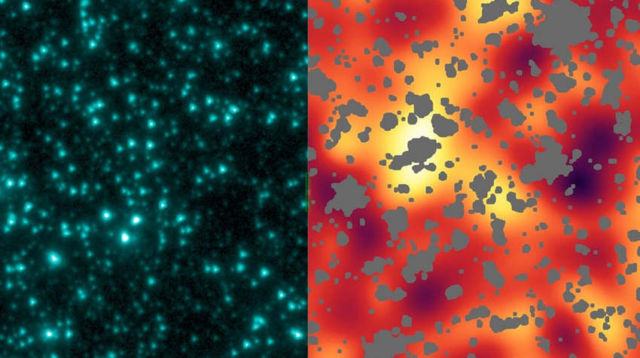A NASA scientist just announced a promising new theory about a possible link between primordial black holes and dark matter.
Dark matter, a mysterious substance composing approximately 27% of the mass and energy in the observable universe, that appears to exert a gravitational force, without emitting any form of energy that scientists can detect, widely thought to be some form of massive exotic particle.
Above, left: This image from NASA’s Spitzer Space Telescope shows an infrared view of a sky area in the constellation Ursa Major. Right: After masking out all known stars, galaxies and artifacts and enhancing what’s left, an irregular background glow appears. This is the cosmic infrared background (CIB); lighter colors indicate brighter areas. The CIB glow is more irregular than can be explained by distant unresolved galaxies, and this excess structure is thought to be light emitted when the universe was less than a billion years old. Scientists say it likely originated from the first luminous objects to form in the universe, which includes both the first stars and black holes. Credits: NASA/JPL-Caltech/A. Kashlinsky (Goddard)
An intriguing alternative view is that dark matter is made of black holes formed during the first second of our universe’s existence, known as primordial black holes.
Now a scientist at NASA’s Goddard Space Flight Center in Greenbelt, Maryland, suggests that this interpretation aligns with our knowledge of cosmic infrared and X-ray background glows and may explain the unexpectedly high masses of merging black holes detected last year.
Alexander Kashlinsky, an astrophysicist at NASA Goddard, said:
“This study is an effort to bring together a broad set of ideas and observations to test how well they fit, and the fit is surprisingly good. If this is correct, then all galaxies, including our own, are embedded within a vast sphere of black holes each about 30 times the sun’s mass.”
Primordial black holes, if they exist, could be similar to the merging black holes detected by the LIGO team in 2014. This computer simulation shows in slow motion what this merger would have looked like up close. The ring around the black holes, called an Einstein ring, arises from all the stars in a small region directly behind the holes whose light is distorted by gravitational lensing. The gravitational waves detected by LIGO are not shown in this video, although their effects can be seen in the Einstein ring. Gravitational waves traveling out behind the black holes disturb stellar images comprising the Einstein ring, causing them to slosh around in the ring even long after the merger is complete. Gravitational waves traveling in other directions cause weaker, shorter-lived sloshing everywhere outside the Einstein ring. If played back in real time, the movie would last about a third of a second. Credits: SXS Lensing
Read more at NASA






Leave A Comment